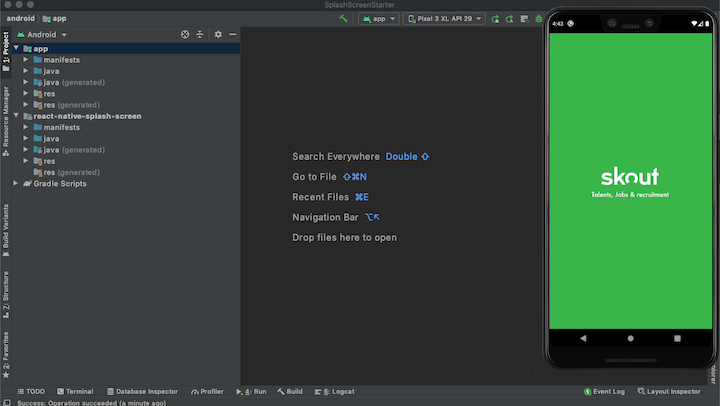Splash Screen is a view which contains Text or Images that shows when the app first starts. This is a common pattern among React developers.

Add A Splash Screen To A React Native App By Appstud Medium
1 Initialise a bare react native app if not already done.

. 2 Install react-native-splash-screen and link the library. Show activity on this post. Finally the Splash Screen is rendered using a React Native Modal.
For this tutorial Ill use Expo. In XCode in the project navigator select your project. React Native Splash Screen.
For Android run the following command. Add libSplashScreena to your projects Build Phases Link Binary With Libraries. This commit does not belong to any branch on this repository and may belong to a fork outside of the repository.
But first we need to create and set up a new React Native project. Create your project using react-native init app-name. Without that information the application may not be able to.
Name the JSON file myloaderjson and keep it at the same level as Appjs. The iOS project from React Native comes with LaunchScreenxib but xib is a thing of the past. For splash screen you will have to use 3rd party plugins like react-native-splash-screen or react-native-bootsplash.
Inside that ceate a file named background_splashxml. It is used when the mobile app requires essential information before its start. Js under the src components directory.
We wanted the animation to play at least once before it is hidden so that. Go to the official Lottie animation website and download Lottie JSON. Right click on MyApp folder - New and chose Launch Screen add it to both targets as usually we show the same splash screen for both staging and production.
Run your project using react-native run-ios. For bare react-native projects npx react-native init appjson does not have any affect. Here a few examples of splash screen generator sites you can use.
In XCode in the project navigator right click Libraries Add Files to your projects name. Create a new Expo app by running. Before we can consider our app truly complete we need to add a splash screen and app icon.
Follow the given steps. Here is what the example app looks like in its current form. Notice that the splash screen and the app icon are defaults that come with React Native.
A React Native CLI plugin with everyday tools for iOS and Android application development. After creating the original app icon. Depending on your package manager of choice.
To add the downloaded animation first import LottieView from lottie-react-native. A splash screen is what users see when the app is launched before it has loaded. 3 Add splashpng to all minmap folders.
Static Splash screen hides Animated splash screen is visible with background task working caching and API call Show activity on this post. Open up appjson from. I know this is a no.
Once youre done run the Expo server. When you publish your app the app icon is what people see on the App StorePlay Store and also on the users home. Splash screen image has no background splashbackgroundColor.
4 Inside the res directory create a folder named drawable. You can configure your splash screen in the appjson file and read about all the properties from the expo guide below. Notice that this components name unlike others start with a with prefix.
Lets delete it and create a file called Launch Screenstoryboard. Adding the Splash Screen Component. Import SplashScreen from react-native-splash-screen.
Npm install react-native-splash-screen --save. Do stuff and hide the splash when you want SplashScreenhide. Hence we will use another react-native method called onLayout which gets called before the render method of the component and inside this onLayout we will hide the.
With your app up and running the next thing you will do is to create a new file called withSplashScreen. Npx react-native run-ios. The application may load the information from some external API or local storage.
Bundle loads call hide function exposed by modules on ComponentDidMount of SplashScreen component. Here is a screen shot of the default splash screen--Next you need to generate your splash screen sizes for different mobile views. Lets go ahead and create a.
Expo since version 29 supports animated SVG and GIF. Go to node_modules react-native-splash-screen and add SplashScreenxcodeproj. Get the splash image ready.
Now for those of us who have built the app with the good-old react-native init adding a splash screen consists of the following 4 steps. Inside the splash key object you can see the image key. How to add a splash-screen to your react-native application in 15 minutes by using bamtechreact-native-make.
In expo project on bare workflow follow this link. Choose a blank template. Were done.
Simple React Native app splash screen. Expo is an open-source platform for making universal native apps for Android iOS and the web with JavaScript and React. Lottie library will be used to add lottie-animations JSON file to your React Native App.
Then go to appjson and see the key splash as an object this will be your SplashScreen configuration. Basic flow of App.

Add A Splash Screen To A React Native App By Appstud Medium

Add A Splash Screen To A React Native App By Appstud Medium

Add A Splash Screen To A React Native App By Appstud Medium

Ionic An Angularjs Based Framework On The Rise Ionic Interview Questions And Answers Framework

Building A Splash Screen In React Native Logrocket Blog

React Native Store Finder Locator For Ios And Android Codelib App Driver App React Native Splash Screen

Espeech Text To Speech Flutter Full App Buy Espeech Text To Speech Flutter Full App By Wrteam On Codecanyon Ama In 2022 Mobile App Templates App App Template

React Native Expo Not Read Googlemobileadsappid In App Json Stack Overflow
0 comments
Post a Comment